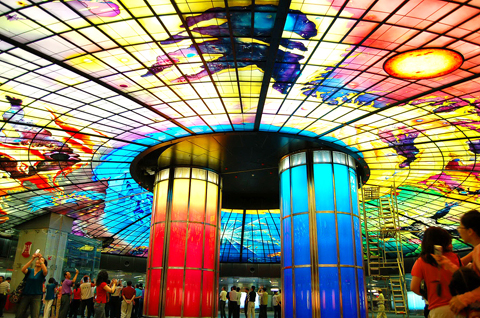Italy’s Narcissus Quagalita, who is seen by many as the world’s greatest glass artist, has entered discussions with the Kaohsiung Rapid Transit Corp (KHRTC) over intellectual property rights and royalties concerning his Dome of Light, which is displayed at the Kaohsiung Mass Rapid Transit (MRT) system’s Formosa Boulevard Station. The talks are focusing on the fact that any use of the artwork for commercial purposes could represent a copyright infringement.
At 30m in diameter and covering an area of about 660 ping (2,180m²), the Dome of Light is in the world’s largest domed underground station.
Quagalita made the piece in cooperation with Derix Glasstudios in Germany. The dome, which is made of 4,500 glass panels, symbolizes rebirth and Taiwan’s democratic process. The four parts that comprise it — water, earth, light and fire — symbolize birth, growth, glory and destruction respectively.

PHOTO: WANG JUNG-HSIANG, TAIPEI TIMES
Located close to where the Kaohsiung Incident occurred, the Formosa Boulevard Station sits at the intersection of the MRT’s red and orange lines.
With the orange line scheduled to begin operations later this month, the KHRTC has developed plans to design and sell souvenirs as well as sell tickets for in-depth tours of Quagalita’s work. Bridal companies have also been lining up to use it as a location for wedding photos.
As the KHRTC only has ownership rights and that any commercial use of the dome involves intellectual property rights, negotiations must be held with the original designer to avoid any copyright infringement.
KHRTC general manager Fan Chen-po (范陳柏) said that such proceedings were international practice and that it was only natural for the KHRTC to follow intellectual property rights and copyright legislation.
The company said its main concern remained ensuring that the work of art does not get damaged or destroyed by visitors.

Taiwan is to commence mass production of the Tien Kung (天弓, “Sky Bow”) III, IV and V missiles by the second quarter of this year if the legislature approves the government’s NT$1.25 trillion (US$39.78 billion) special defense budget, an official said yesterday. Commenting on condition of anonymity, a defense official with knowledge of the matter said that the advanced systems are expected to provide crucial capabilities against ballistic and cruise missiles for the proposed “T-Dome,” an advanced, multi-layered air defense network. The Tien Kung III is an air defense missile with a maximum interception altitude of 35km. The Tien Kung IV and V

The disruption of 941 flights in and out of Taiwan due to China’s large-scale military exercises was no accident, but rather the result of a “quasi-blockade” used to simulate creating the air and sea routes needed for an amphibious landing, a military expert said. The disruptions occurred on Tuesday and lasted about 10 hours as China conducted live-fire drills in the Taiwan Strait. The Civil Aviation Administration (CAA) said the exercises affected 857 international flights and 84 domestic flights, affecting more than 100,000 travelers. Su Tzu-yun (蘇紫雲), a research fellow at the government-sponsored Institute for National Defense and Security Research, said the air

Taiwan lacks effective and cost-efficient armaments to intercept rockets, making the planned “T-Dome” interception system necessary, two experts said on Tuesday. The concerns were raised after China’s military fired two waves of rockets during live-fire drills around Taiwan on Tuesday, part of two-day exercises code-named “Justice Mission 2025.” The first wave involved 17 rockets launched at 9am from Pingtan in China’s Fujian Province, according to Lieutenant General Hsieh Jih-sheng (謝日升) of the Office of the Deputy Chief of the General Staff for Intelligence at the Ministry of National Defense. Those rockets landed 70 nautical miles (129.6km) northeast of Keelung without flying over Taiwan,

A strong continental cold air mass is to bring pollutants to Taiwan from tomorrow, the Ministry of Environment said today, as it issued an “orange” air quality alert for most of the country. All of Taiwan except for Hualien and Taitung counties is to be under an “orange” air quality alert tomorrow, indicating air quality that is unhealthy for sensitive groups. In China, areas from Shandong to Shanghai have been enveloped in haze since Saturday, the ministry said in a news release. Yesterday, hourly concentrations of PM2.5 in these areas ranged from 65 to 160 micrograms per cubic meter (mg/m³), and pollutants were